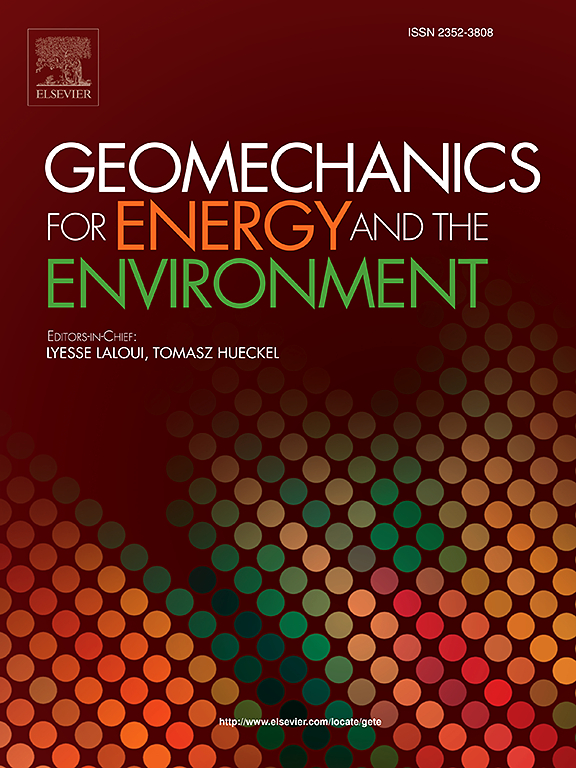煤岩在三轴扰动下的渐进破坏:从实验和裂纹扩展模型的角度
IF 3.7
2区 工程技术
Q3 ENERGY & FUELS
引用次数: 0
摘要
在深部开采过程中,煤岩体在三轴卸荷扰动下容易发生动应力重分布和集中,导致裂隙逐步演化,最终失稳。为了研究其潜在的破坏机制,进行了三轴卸荷扰动试验。采用声发射(AE)监测,对RA/AF比、b值、主导频率等关键指标进行跟踪。此外,引入多重分形谱分析,系统表征了煤岩在不同围压卸载速率下的裂纹演化过程。研究将破坏过程分为4个阶段,提出了基于断裂力学的轴向裂纹扩展模型来描述扰动卸载条件下的裂纹演化。结果表明:随着卸荷速率的增加,煤岩破坏以剪切破坏为主,宏观裂缝数量减少;声发射信号表现出更强的多重分形特征和局部强度非均质性,反映了内部结构复杂性和无序性的增加。所建立的裂缝扩展模型为非常规载荷条件下地质材料裂缝演化研究提供了理论支持,为复杂应力环境下裂缝预测和破坏评价提供了指导。本文章由计算机程序翻译,如有差异,请以英文原文为准。
Progressive failure of coal–rock under triaxial disturbance: From experimental and crack propagation modeling perspectives
During deep mining, coal–rock masses are prone to dynamic stress redistribution and concentration under triaxial unloading disturbances, leading to progressive crack evolution and eventual instability. To investigate the underlying failure mechanism, triaxial unloading disturbance tests were carried out. Acoustic emission (AE) monitoring was used to track key indicators, including the RA/AF ratio, b-value, and dominant frequency. In addition, multifractal spectrum analysis was introduced to systematically characterize the crack evolution process of coal–rock under different unloading rates of confining pressure. The study divides the failure process into four stages and proposes an axial crack propagation model based on fracture mechanics to describe crack evolution under disturbed unloading conditions. The results indicate that, with increasing unloading rates, coal–rock failure is dominated by shear failure, accompanied by a reduction in the number of macroscopic cracks. The acoustic emission (AE) signals exhibit stronger multifractal characteristics and localized intensity heterogeneity, reflecting increased internal structural complexity and disorder. The developed crack propagation model provides theoretical support for the study of fracture evolution in geological materials under unconventional loading conditions and offers guidance for crack prediction and failure assessment in complex stress environments.
求助全文
通过发布文献求助,成功后即可免费获取论文全文。
去求助
来源期刊

Geomechanics for Energy and the Environment
Earth and Planetary Sciences-Geotechnical Engineering and Engineering Geology
CiteScore
5.90
自引率
11.80%
发文量
87
期刊介绍:
The aim of the Journal is to publish research results of the highest quality and of lasting importance on the subject of geomechanics, with the focus on applications to geological energy production and storage, and the interaction of soils and rocks with the natural and engineered environment. Special attention is given to concepts and developments of new energy geotechnologies that comprise intrinsic mechanisms protecting the environment against a potential engineering induced damage, hence warranting sustainable usage of energy resources.
The scope of the journal is broad, including fundamental concepts in geomechanics and mechanics of porous media, the experiments and analysis of novel phenomena and applications. Of special interest are issues resulting from coupling of particular physics, chemistry and biology of external forcings, as well as of pore fluid/gas and minerals to the solid mechanics of the medium skeleton and pore fluid mechanics. The multi-scale and inter-scale interactions between the phenomena and the behavior representations are also of particular interest. Contributions to general theoretical approach to these issues, but of potential reference to geomechanics in its context of energy and the environment are also most welcome.
 求助内容:
求助内容: 应助结果提醒方式:
应助结果提醒方式:


